Module 10 - Introduction to Wave Propagation, Transmission Lines, and Antennas
Pages i,
1-1,
1-11,
1-21,
1-31,
1-41,
2-1,
2-11,
2-21,
2-31,
2-40,
3-1,
3-11,
3-21,
3-31,
3-41,
3-51,
4-1,
4-11,
4-21,
4-31,
4-41,
4-51, Index
Methods of Feeding
Energy to an Antenna Voltage and current distribution for the half-wave antenna (shown in figure
4-16) is the same as that for the antenna discussed earlier in this chapter. a point closely related to the
voltage and current distribution on an antenna is the method of feeding the transmitter output to the antenna. The
simplest method of feeding energy to the half-wave antenna is to connect one end through a capacitor to the final
output stage of the transmitter. This method is often called the END-FEED or Voltage-FEED method. In this method
the antenna is fed at a point of high voltage (the end).
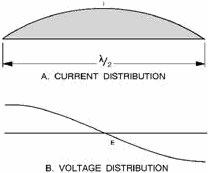
Figure 4-16. - Standing waves of current and voltage. Energy may also be fed to the half-wave antenna by dividing the antenna at its center and connecting the
transmission line from the final transmitter output stage to the two center ends of the halved antenna. Since the
antenna is now being fed at the center (a point of low voltage and high current), this type of feed is known as
the CENTER-FEED or CURRENT-FEED method. The point of feed is important in determining the type of transmission
line to be used. QUARTER-WAVE Antennas As you have studied in the previous
sections, a 1/2 wavelength antenna is the shortest antenna that can be used in free space. If we cut a half-wave
antenna in half and then ground one end, we will have a grounded quarter-wave antenna. This antenna will resonate
at the same frequency as the ungrounded half- wave antenna. Such an antenna is referred to as a QUARTER-WAVE or
Marconi antenna. Quarter-wave antennas are widely used in the military. Most mobile transmitting and receiving
antennas (fig. 4-17) are quarter-wave antennas.
4-21

Figure 4-17. - Mobile antennas. As stated above, a grounded quarter-wave antenna will resonate at the same frequency as an ungrounded
half-wave antenna. This is because ground has high conductivity and acts as an electrical mirror image. This
characteristic provides the missing half of the antenna, as shown in the bottom part of figure 4-18. In other
words, the grounded quarter-wave antenna acts as if another quarter-wave were actually down in the earth.
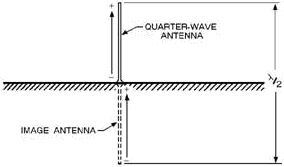
Figure 4-18. - Grounded quarter-wave antenna image. Characteristics of Quarter-Wave Antennas The grounded end of the quarter-wave
antenna has a low input impedance and has low voltage and high current at the input end, as shown in figure 4-18.
The ungrounded end has a high impedance, which causes high voltage and low current. The directional
characteristics of a grounded quarter-wave antenna are the same as those of a half-wave antenna in free space.
As explained earlier, ground losses affect radiation patterns and cause high signal losses for some
frequencies. Such losses may be greatly reduced if a perfectly conducting ground is provided in the
4-22
vicinity of the antenna. This is the purpose of a Ground SCREEN (figure 4-19, view A) and COUNTERPOIsE
view B.
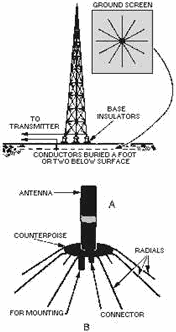
Figure 4-19. - Groundscreen and counterpoise. The ground screen in view a is composed of a series of conductors buried 1 or 2 feet (0.3 to 0.6 meter)
below the surface of the earth and arranged in a radial pattern. These conductors reduce losses in the ground in
the immediate vicinity of the antenna. Such a radial system of conductors is usually 1/2 wavelength in diameter.
a counterpoise view B is used when easy access to the base of the antenna is necessary. It is also used when the
earth is not a good conducting surface, such as ground that is sandy or solid rock. The counterpoise serves the
same purpose as the ground screen but it is usually elevated above the earth. No specific dimensions are necessary
in the construction of a counterpoise nor is the number of wires particularly critical. a practical counterpoise
may be assembled from a large screen of chicken wire or some similar material. This screen may be placed on the
ground, but better results are obtained if it is placed a few feet above the ground. Q20. Since the
radiation pattern of a dipole is similar to that of a doublet, what will happen to the pattern if the length of
the doublet is increased?
Q21. What is the simplest method of feeding power to the half-wave antenna?
4-23
Q22. What is the radiation pattern of a quarter-wave antenna? Q23. Describe the physical
arrangement of a ground screen. FOLDED DIPOLE The use of parasitic elements
and various stacking arrangements causes a reduction in the radiation resistance of a center-fed, half-wave
antenna. Under these conditions obtaining a proper impedance match between the radiator and the transmission line
is often difficult. a convenient method of overcoming these difficulties is to use a FOLDED DIPOLE in place of the
center-fed radiator. (See views a and B of figure 4-20).
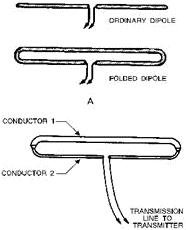
Figure 4-20. - Folded-dipole antennas. A FOLDED DIPOLE is an ordinary half-wave antenna that has one or more additional conductors connected
across its ends. Additional conductors are mounted parallel to the dipole elements at a distance equal to a very
small fraction of a wavelength. Spacing of several inches is common. The feed-point impedance can be
further increased by using three or four properly spaced parallel conductors. Standard feed-line SPREADERS are used to maintain this spacing when required. In any folded dipole, the increase of impedance is the square of the
number of conductors used in the radiator. Thus, a three-wire dipole has nine times (32) the feed-point impedance
of a simple center-fed dipole. a second method of stepping up the impedance of a folded dipole is to use two
conductors with different radii, as shown in view B. The directional characteristics of a folded dipole
are the same as those of a simple dipole. However, the reactance of a folded dipole varies much more slowly as the
frequency is varied from resonance. Because of this the folded dipole can be used over a much wider frequency
range than is possible with a simple dipole.
4-24
Q24. What is the difference in the amount of impedance between a three-wire dipole and a simple
center-fed dipole? Q25. Which has a wider frequency range, a simple dipole or a folded dipole?
ARRAY Antennas An array antenna is a special arrangement of basic antenna components involving new factors and
concepts. Before you begin studying about arrays, you need to study some new terminology.
DEFINITION of TERMS An array antenna is made up of more than one ELEMENT, but the basic element
is generally the dipole. Sometimes the basic element is made longer or shorter than a half-wave, but the deviation
usually is not great. A DRIVEN element is similar to the dipole you have been studying and is connected
directly to the transmission line. It obtains its power directly from the transmitter or, as a receiving antenna,
it delivers the received energy directly to the receiver. a PARASITIC ELEMENT is located near the driven element
from which it gets its power. It is placed close enough to the driven element to permit coupling. A
parasitic element is sometimes placed so it will produce maximum radiation (during transmission) from its
associated driver. When it operates to reinforce energy coming from the driver toward itself, the parasitic
element is referred to as a DirectOR. If a parasitic element is placed so it causes maximum energy radiation in a
direction away from itself and toward the driven element, that parasitic element is called a Reflector. If
all of the elements in an array are driven, the array is referred to as a DRIVEN ARRAY (sometimes as a CONNECTED
ARRAY). If one or more elements are parasitic, the entire system usually is considered to be a PARASITIC ARRAY.
MULTIELEMENT ARRAYS frequently are classified according to their directivity. a BIDirectIONAL ARRAY radiates
in opposite directions along the line of maximum radiation. a UNIDirectIONAL ARRAY radiates in only one general
direction. Arrays can be described with respect to their radiation patterns and the types of elements of
which they are made. However, you will find it useful to identify them by the physical placement of the elements
and the direction of radiation with respect to these elements. Generally speaking, the term BROADSIDE ARRAY
designates an array in which the direction of maximum radiation is perpendicular to the plane containing these
elements. In actual practice, this term is confined to those arrays in which the elements themselves are also
broadside, or parallel, with respect to each other.
a COLLINEAR ARRAY is one in which all the elements lie in a straight line with no radiation at the ends of the
array. The direction of maximum radiation is perpendicular to the axis of the elements. An END-FIRE ARRAY
is one in which the principal direction of radiation is along the plane of the array and perpendicular to the
elements. Radiation is from the end of the array, which is the reason this arrangement is referred to as an
end-fire array.
Sometimes a system uses the characteristics of more than one of the three types mentioned. For instance, some of
the elements may be collinear while others may be parallel. Such an arrangement is
4-25
often referred to as a Combination ARRAY or an ARRAY of ARRAYS. Since maximum radiation occurs at
right angles to the plane of the array, the term broadside array is also used. The FRONT-to-BACK RATIO is
the ratio of the energy radiated in the principal direction compared to the energy radiated in the opposite
direction for a given antenna. PHASING Various reflected and refracted components
of the propagated wave create effects of reinforcement and cancellation. At certain distant points from the
transmitter, some of the wave components meet in space. Reception at these points is either impaired or improved.
If the different components arrive at a given point in the same phase, they add, making a stronger signal
available. If they arrive out of phase, they cancel, reducing the signal strength. Radiation
Pattern
Effects similar to those described in the preceding paragraph can be produced at the transmitting point itself.
Consider the antennas shown in figure 4-21, views a and B. View a shows an unobstructed view of the radiation
pattern of a single dipole. In view B two dipoles, shown as points 1 and 2, are perpendicular to the plane of the
page. They are spaced 1/4 wavelength apart at the operating frequency. The radiation pattern from either antenna 1
or 2, operating alone, would be uniform in all directions in this plane, as shown in view A. Suppose that current
is being fed to both antennas from the same transmitter in such a way that the current fed to antenna 2 lags the
current in antenna 1 by 90 degrees. Energy radiating from antenna 1 toward receiving location X will reach antenna
2 after 1/4 cycle of operation. The energy from both antennas will add, and propagation toward X will be strong.

Figure 4-21. - Phasing of antenna in free space. Radiation from antenna 2 toward receiving location Y will reach antenna 1 after 1/4 cycle. The energy in
antenna 1 was 1/4 cycle behind that of antenna 2 to begin with; therefore, the radiation from antenna 1 toward
receiving point Y will be exactly 180 degrees out of phase with that of antenna 2. As a result, the radiation
fields will cancel and there will be no radiation toward Y. At receiving points away from the line of
radiation, phase differences occur between 0 and 180 degrees, producing varying amounts of energy in that
direction. The overall effect is shown by the
4-26
radiation pattern shown in view B. The physical phase relationship caused by the 1/4-wavelength
spacing between the two elements, as well as the phase of the currents in the elements, has acted to change the
radiation pattern of the individual antennas. Stub Phasing In the case just
discussed, the currents fed to the two antennas from the same transmitter were 90 degrees out of phase. Sections
of transmission line, called STUBS, are frequently used for this purpose. These stubs can be adjusted to produce
any desired phase relationship between connected elements. When two collinear half-wave elements are
connected directly so their currents are in the same phase, the effect is the same as that of a full-wave antenna,
as shown in figure 4-22, view A. The current in the first 1/2 wavelength is exactly 180 degrees out of phase with
that in the second 1/2 wavelength. This is the opposite of the desired condition. In the illustration, arrows
are used to indicate the direction of current flow in the antenna. (Using arrows is a convenient means of
determining the phase on more
complicated arrays.)
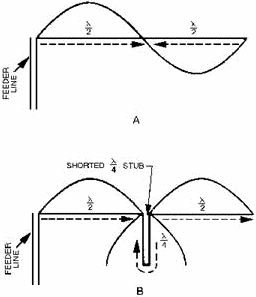
Figure 4-22. - Phasing of connected elements. When the two elements are connected by a shorted 1/4-wavelength stub, as shown in view B, current
travels down one side of the stub and up the other. It travels a distance of a 1/2 wavelength in the stub itself.
As a result, the current moves through 1/2 cycle of change. When the current reaches the second element, it is in
the desired phase. Since the current on one side of the stub is equal and opposite to the current on the other
side, the fields produced here cancel and no radiation is transmitted from the stub itself.
4-27
DirectIVITY The DirectIVITY of an antenna or an array can be determined by
looking at its radiation pattern. In an array propagating a given amount of energy, more radiation takes place in
certain directions than in others. The elements in the array can be altered in such a way that they change the
pattern and distribute it more uniformly in all directions. The elements can be considered as a group of antennas
fed from a common source and facing different directions. On the other hand, the elements could be arranged so
that the radiation would be focused in a single direction. With no increase in power from the transmitter, the
amount of radiation in a given direction would be greater. Since the input power has no increase, this increased
directivity is achieved at the expense of gain in other directions. Directivity and Interference
In many applications, sharp directivity is desirable although no need exists for added gain. Examine the physical
disposition of the units shown in figure 4-23. Transmitters 1 and 2 are sending information to receivers 1 and 2,
respectively, along the paths shown by the solid arrows. The distance between transmitter 1 and receiver 1 or
between transmitter 2 and receiver 2 is short and does not require high- power transmission. The antennas of the
transmitters propagate well in all directions. However, receiver 1 picks up some of the signals from transmitter
2, and receiver 2 picks up some of the signals from transmitter 1, as shown by the broken arrows. This effect is
emphasized if the receiving antennas intercept energy equally well in all directions.

Figure 4-23. - Directivity and interference. The use of highly directional arrays as radiators from the transmitters tends to solve the problem. The
signals are beamed along the paths of the solid arrows and provide very low radiation along the paths of the
broken arrows. Further improvement along these lines is obtained by the use of narrowly directed arrays as
receiving antennas. The effect of this arrangement is to select the desired signal while discriminating against
all other signals. This same approach can be used to overcome other types of radiated interference. In such cases,
preventing radiation in certain directions is more important than producing greater gain in other directions.
Look at the differences between the field patterns of the single-element antenna and the array, as illustrated in
figure 4-24. View a shows the relative field-strength pattern for a horizontally polarized single antenna. View B
shows the horizontal-radiation pattern for an array. The antenna in view a
4-28
radiates fairly efficiently in the desired direction toward receiving point X. It radiates equally as
efficiently toward Y, although no radiation is desired in this direction. The antenna in view B radiates strongly
to point X, but very little in the direction of point Y, which results in more satisfactory operation.
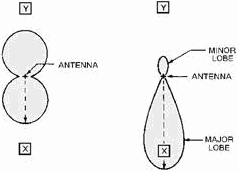
Figure 4-24. - Single antenna versus array. Major and Minor Lobes The pattern shown in figure 4-24, view B, has radiation
concentrated in two lobes. The radiation intensity in one lobe is considerably stronger than in the other. The
lobe toward point X is called a MAJOR LOBE; the other is a MINOR LOBE. Since the complex radiation patterns
associated with arrays frequently contain several lobes of varying intensity, you should learn to use appropriate
terminology. In general, major lobes are those in which the greatest amount of radiation occurs. Minor lobes are
those in which the radiation intensity is least. Q26. What is the purpose of antenna stubs?
Q27. What is the primary difference between the major and minor lobes of a radiation pattern?
DirectIONAL ARRAYS You have already learned about radiation patterns and directivity of
radiation. These topics are important to you because using an antenna with an improper radiation pattern or with
the wrong directivity will decrease the overall performance of the system. In the following paragraphs, we discuss
in more detail the various types of directional antenna arrays mentioned briefly in the "definition of terms"
paragraph above. Collinear Array The pattern radiated by the collinear array is
similar to that produced by a single dipole. The addition of the second radiator, however, tends to intensify the
pattern. Compare the radiation pattern of the dipole (view a of figure 4-25) and the two-element antenna in view
B. You will see that each pattern consists of two major lobes in opposite directions along the same axis, QQ1.
There is little or no radiation along the
4-29
PP1 axis. QQ1 represents the line of maximum propagation. You can see that radiation is stronger with
an added element. The pattern in view B is sharper, or more directive, than that in view A. This means that the
gain along the line of maximum energy propagation is increased and the beam width is decreased. As more elements
are added, the effect is heightened, as shown in view C. Unimportant minor lobes are generated as more elements
are added.

Figure 4-25. - Single half-wave antenna versus two half-wave antennas in phase. More than four elements are seldom used because accumulated losses cause the elements farther from the
point of feeding to have less current than the nearer ones. This introduces an unbalanced condition in the system
and impairs its efficiency. Space limitations often are another reason for restricting the number of elements.
Since this type of array is in a single line, rather than in a vertically stacked arrangement, the use of too many
elements results in an antenna several wavelengths long. Radiation Pattern. - The
characteristic radiation pattern of a given array is obtained at the frequency or band of frequencies at which the
system is resonant. The gain and directivity characteristics are lost when the antenna is not used at or near this
frequency and the array tunes too sharply. a collinear antenna is more effective than an end-fire array when used
off its tuned frequency. This feature is considered when transmission or reception is to be over a wide frequency
band. When more than two elements are used, this advantage largely disappears. LENGTH and PHASING. - Although
the 1/2 wavelength is the basis for the collinear element, you will find that greater lengths are often used.
Effective arrays of this type have been constructed in which the elements are 0.7 and even 0.8 wavelength long.
This type of array provides efficient operation at more than one frequency or over a wider frequency range.
Whatever length is decided upon, all of the elements in a particular array should closely adhere to that length.
If elements of different lengths are combined, current phasing and distribution are changed, throwing the system
out of balance and seriously affecting the radiation pattern. Q28. What is the maximum number of
elements ordinarily used in a collinear array? Q29. Why is the number of elements used in a collinear
array limited?
Q30. How can the frequency range of a collinear array be increased? Q31. How is directivity of a
collinear array affected when the number of elements is increased? SPACING. - The lower
relative efficiency of collinear arrays of many elements, compared with other multi-element arrays, relates
directly to spacing and mutual impedance effects. Mutual impedance is
4-30
| - |
Matter, Energy,
and Direct Current |
| - |
Alternating Current and Transformers |
| - |
Circuit Protection, Control, and Measurement |
| - |
Electrical Conductors, Wiring Techniques,
and Schematic Reading |
| - |
Generators and Motors |
| - |
Electronic Emission, Tubes, and Power Supplies |
| - |
Solid-State Devices and Power Supplies |
| - |
Amplifiers |
| - |
Wave-Generation and Wave-Shaping Circuits |
| - |
Wave Propagation, Transmission Lines, and
Antennas |
| - |
Microwave Principles |
| - |
Modulation Principles |
| - |
Introduction to Number Systems and Logic Circuits |
| - |
- Introduction to Microelectronics |
| - |
Principles of Synchros, Servos, and Gyros |
| - |
Introduction to Test Equipment |
| - |
Radio-Frequency Communications Principles |
| - |
Radar Principles |
| - |
The Technician's Handbook, Master Glossary |
| - |
Test Methods and Practices |
| - |
Introduction to Digital Computers |
| - |
Magnetic Recording |
| - |
Introduction to Fiber Optics |
| Note: Navy Electricity and Electronics Training
Series (NEETS) content is U.S. Navy property in the public domain. |
|


















